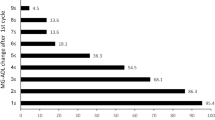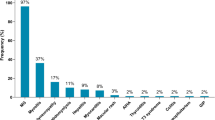Abstract
Introduction
Refractory myasthenia gravis (MG) is defined as a failure to respond adequately to conventional therapies, the inability to reduce immunosuppressive therapy without clinical relapse or the need for ongoing rescue therapy, severe adverse effects from immunosuppressive therapy (treatment intolerant) or frequent myasthenic crisis even on therapy. Cyclophosphamide (CYC) is a DNA alkylating agent that causes important interference in transcription processes and DNA replication, it has been used in refractory MG with controversial results. We aim to determine the efficacy of CYC in refractory MG in the Mexican population.
Methods
In an observational, longitudinal retrospective study, we identified eight refractory MG patients treated with 30–50 mg/kg monthly CYC for at least 6 months. The efficacy was assessed by Osserman scale considering significant improvement a ≥ 1 point reduction and Myasthenia Gravis Composite Scale. The relapse-free and remission-free period were also calculated using the Kaplan–Meier statistic.
Results
Clinical improvement was achieved in 75% of the patients. According to the Kaplan–Meier analysis, the median progression-free survival (PFS) was 9 (6.2–11.5) months and the median time to progression (TTP) was 4 (1–8) months. Response was independent of patient's characteristics, except for the MG age of onset (p = 0.0025).
Conclusions
CYC was effective in all patients with refractory MG for a mean of 9 months, with worsening thereafter, which could be associated with low cumulative dose. The symptomatic improvement with CYC was noted within the 1st month. We conclude that CYC is effective as an induction to remission therapy, although our data suggest it is not effective as a long-term therapy.

Similar content being viewed by others
References
Sieb JP (2014) Myasthenia gravis: an update for the clinician. Clin Exp Immunol. https://doi.org/10.1111/cei.12217
Vincent A (2002) Unravelling the pathogenesis of myasthenia gravis. Nat Rev Immunol. https://doi.org/10.1038/nri916
Ha JC, Richman DP (2015) Myasthenia gravis and related disorders: Pathology and molecular pathogenesis. Biochim Biophys Acta-Mol Basis Dis. https://doi.org/10.1016/j.bbadis.2014.11.022
Keesey JC (2004) Clinical evaluation and management of myasthenia gravis. Muscle Nerve. https://doi.org/10.1002/mus.20030
Gilhus NE, Verschuuren JJ (2015) Myasthenia gravis: Subgroup classification and therapeutic strategies. Lancet Neurol. https://doi.org/10.1016/S1474-4422(15)00145-3
Mantegazza R, Antozzi C (2018) When myasthenia gravis is deemed refractory: clinical signposts and treatment strategies. Ther Adv Neurol Disord 11:1756285617749134–1756285617749134. https://doi.org/10.1177/1756285617749134
Sanders DB, Wolfe GI, Benatar M et al (2016) International consensus guidance for management of myasthenia gravis. Neurology. 87(4):419–425. https://doi.org/10.1212/WNL.0000000000002790
Cortese I, Chaudhry V, So YT, Cantor F, Cornblath DR, Rae-Grant A (2011) Evidence-based guideline update: plasmapheresis in neurologic disorders: Report of the Therapeutics and Technology Assessment Subcommittee of the American Academy of Neurology. Neurology. https://doi.org/10.1212/WNL.0b013e318207b1f6
Zinman L, Ng E, Bril V (2007) IV immunoglobulin in patients with myasthenia gravis: a randomized controlled trial. Neurology. https://doi.org/10.1212/01.wnl.0000256698.69121.45
Gajdos P, Chevret S, Toyka K (2008) Intravenous immunoglobulin for myasthenia gravis. Cochrane Database Syst Rev. https://doi.org/10.1002/14651858.CD002277.pub3
Batocchi AP, Evoli A, Di SC, Tonali P (2000) Therapeutic apheresis in myasthenia gravis. Ther Apher. https://doi.org/10.1046/j.1526-0968.2000.004004275.x
Gladstone DE, Brannagan TH, Schwartzman RJ, Prestrud AA, Brodsky I (2004) High dose cyclophosphamide for severe refractory myasthenia gravis. J Neurol Neurosurg Psychiatry. https://doi.org/10.1136/jnnp.2003.019232
Lin PT, Martin BA, Weinacker AB, So YT (2006) High-dose cyclophosphamide in refractory myasthenia gravis with MuSK antibodies. Muscle Nerve. https://doi.org/10.1002/mus.20411
Sanders DB, Evoli A (2010) Immunosuppressive therapies in myasthenia gravis. Autoimmunity. https://doi.org/10.3109/08916930903518107
Zebardast N, Patwa HS, Novella SP, Goldstein JM (2010) Rituximab in the management of refractory myasthenia gravis. Muscle Nerve. https://doi.org/10.1002/mus.21521
Tandan R, Hehir MK, Waheed W, Howard DB (2017) Rituximab treatment of myasthenia gravis: a systematic review. Muscle Nerve. https://doi.org/10.1002/mus.25597
De Feo LG, Schottlender J, Martelli NA, Molfino NA (2002) Use of intravenous pulsed cyclophosphamide in severe, generalized myasthenia gravis. Muscle Nerve. https://doi.org/10.1002/mus.10133
Drachman DB, Jones RJ, Brodsky RA (2003) Treatment of refractory myasthenia: “Rebooting” with high-dose cyclophosphamide. Ann Neurol. https://doi.org/10.1002/ana.10400
Buzzard KA, Meyer NJ, Hardy TA, Riminton DS, Reddel SW (2015) Induction intravenous cyclophosphamide followed by maintenance oral immunosuppression in refractory myasthenia gravis. Muscle Nerve. https://doi.org/10.1002/mus.24536
Author information
Authors and Affiliations
Contributions
Contributions V-C and L-H were in charge of the diagnosis, treatment care and follow up of the patient and supervised the elaboration of the manuscript. G-F and B-R data analysis and organization. G-T, C-U and C-L prepared the draft.
Corresponding author
Ethics declarations
Conflicts of interest
All authors declare no competing interests or external funding.
Ethical standards
Authors have read the journal's position on issues involved in ethical publication. This study was approved by the research ethics committee of our institution.
Rights and permissions
About this article
Cite this article
Gomez-Figueroa, E., Garcia-Trejo, S., Bazan-Rodriguez, L. et al. Intravenous cyclophosphamide monthly pulses in refractory myasthenia gravis. J Neurol 267, 674–678 (2020). https://doi.org/10.1007/s00415-019-09622-4
Received:
Revised:
Accepted:
Published:
Issue Date:
DOI: https://doi.org/10.1007/s00415-019-09622-4




